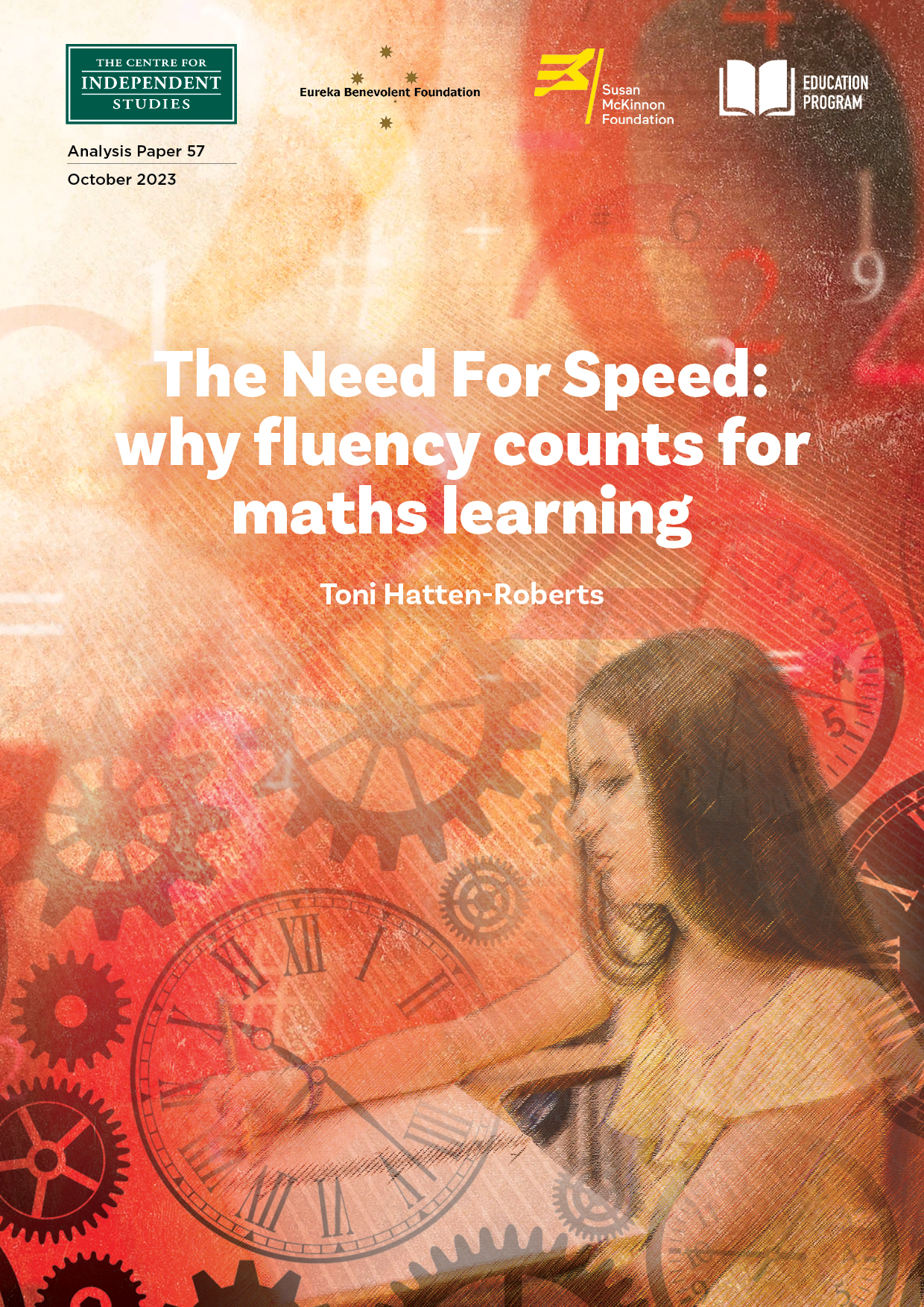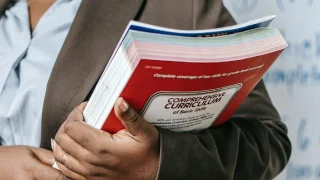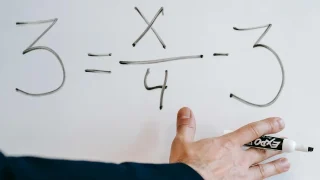

1. Introduction
Australia has a problem in maths achievement which is shown in stark relief by the declining number of students taking the subject in senior years. A recent report by the Australian Mathematical Sciences Institute (AMSI) identified significant falls in the number of Year 11 and 12 students choosing to enrol in high-level mathematics subjects. This dropped from an average of 71-73% over the last 10 years, to a new low of 66%. This is likely to impact Australia’s future workforce.[1]
One of the most significant reasons students look to ‘drop’ maths (or any subject for that matter) is based on their ability to be successful at it. Generally speaking, a student is less likely to continue if he or she has trouble succeeding. According to the PISA,[2] Australian 15-year-olds are falling behind in their mathematical skills. Compared to their Australian peers in 2003, they are at least one year behind, and three years behind those in Singapore, the top-performing country. The report found that 46% of 15-year-olds do not meet the national standard of proficiency in mathematics, indicating that almost half of the student population is struggling in this subject.
This decline in mathematics performance reflects the way the subject is being taught across Australia and other Western countries, with the prioritising of conceptual understanding of maths over procedural and factual fluency, with the latter often derided as damaging to students’ understanding.[3]
The current dominant thought in mathematics classrooms around Australia, is that students must build conceptual knowledge first to help them invent and understand the procedures. This is despite mathematical fluency being a foundational skill that underpins these higher-level skills. Without a strong foundation in basic mathematics, students will likely struggle to apply problem-solving and reasoning skills effectively.
Mathematical fluency refers to the ability to perform mathematical calculations using well-rehearsed procedures quickly and accurately and includes the ability to recall facts to the point of automaticity. It also involves a strong understanding of mathematical vocabulary and symbols, as well as the ability to read and interpret mathematical expressions and equations. Fluency provides a foundation for higher-level mathematics skills needed for problem-solving, reasoning, and critical thinking, as well as real-world problem-solving while promoting efficiency and confidence. When students are fluent in basic mathematical skills, mathematics anxiety is reduced and a positive attitude towards mathematics is fostered.
However, if fluency is the foundation of mathematical development, Australian students have yet to master it, as evidenced by their poor performance. Based on experience working with more than a hundred schools in Queensland, Northern Territory, NSW, Victoria, Western Australia, the ACT, and Tasmania, teachers consistently report that students struggle with recalling basic mathematical facts. If you were to ask a high school maths teacher what one maths skill they believe is most important for students to learn in primary school, they would likely say the ability to quickly recall multiplication tables and division facts. This foundational knowledge is crucial for future mathematical concepts such as geometry, fractions, factors, rates, ratios, and algebra, all taught beyond Year 4.
Students who have foundational maths fact knowledge easily recalled from memory, are more likely to develop the prerequisite skills for solving more complex problems and can interpret more abstract principles.
Studies on mathematics achievement [4] have shown that students who excel in mathematics at an early grade level, are likely to maintain their success in subsequent grades. Conversely, students who struggle in the earlier grades are more likely to face challenges in the future.[5] It is essential for schools to provide high-quality mathematics instruction that includes routines for fact and procedural fluency.
Alongside this, there is a need for a ‘point of time’ indicator, much like the check introduced in the UK to identify students who have gaps in automatic recall of facts, particularly multiplication. This will help identify early, the students who have not mastered procedural fluency for addition, subtraction, multiplication and division using the standard algorithm.
2. The importance of timed assessments
Timed assessments are a measure where students can recall the facts with automaticity, with little hesitation and provide the teacher with information on the mastery point of student learning. Students who have high rates in reading typically have low rates of error. The same can be found in research on timed maths fluency. [6] Monitoring whether students have attained fluency, determined by both accuracy and speed can only be done through regularly timed tests that track and measure how close to automaticity students are getting.[7]
Suggestions that timed maths facts tests to measure fluency are a cause for anxiety lacks research to support such claims with no causal evidence found.[8] Research by Gunderson, et al. (2018)[9] found the main cause of mathematics anxiety is based on whether students lack skills. Schools that follow a ‘science of reading’ approach consistently use timed fluency to measure reading, yet none report anxiety about reading. Why? Because the students are time-tested on what they have explicitly been practising. When monitoring reading fluency, teachers can measure current student performance and allow insight into future performance in reading based on how many words per minute they read with accuracy.
The same applies to mathematics. Data collated can be used to support the development of factual fluency as a necessary prerequisite to higher mathematics acquisition.[10] Additionally, evidence suggests that students who are confident in this area of mathematics, confidence permeates to other areas of mathematical problem-solving.[11] From a cognitive science perspective, timed tests have the added benefit of an instructional approach used for retrieval practice, a strategy for learning. Effortless retrieval of declarative facts reduces the cognitive load when students work with higher levels of mathematical problems. Students who recall their basic facts accurately and quickly have greater cognitive resources available to learn more complex tasks or concepts. So, a daily timed test, after some paired verbal rehearsal of a set of facts with a classmate, becomes a daily learning experience just like reading fluency routines.
TEXT BOX The Maths Wars and misconceptions about fluency
The ‘Maths Wars’ describes a long-standing debate in the field of mathematics education regarding the best way to teach maths. The debate centres around varying beliefs regarding two key issues: what knowledge to prioritise when teaching new content to students and the relevant priority placed on mathematical fluency through timed assessments.
There are competing views as to the relative importance teachers place on developing either procedural knowledge to solve mathematical problems, or on constructing students’ conceptual knowledge.[12] Conceptual proponents argue that mathematics education should emphasise problem-solving, reasoning, and critical thinking skills, as these are essential for success in higher-level maths and real-world contexts. This is partly based on a belief that students only learn when they discover mathematical concepts for themselves, such as through independent inquiry or exploration activities. Moreover, it is also implied that students must be encouraged to explore mathematical concepts in-depth, well before exposing students to standard procedures or algorithms. It is also argued that this exploration will lead to a deeper understanding of mathematics and better problem-solving skills. However this dichotomy is false, as conceptual and procedural knowledge are deeply intertwined and iterative. Both concepts and procedures reinforce each other. Research shows that there is no optimal ordering for teaching either concepts or procedures first, as outlined in a CIS analysis paper last year, Myths That Undermine Maths Teaching, by Sarah H. Powell, Elizabeth M. Hughes and Corey Peltier [AP38 August 2022, Page 2].
It is often feared that memorisation of key maths facts like the multiplication tables is insufficient for students to truly understand mathematics and that an approach prioritising mathematical fluency could lead to a narrow view of mathematics that neglects important conceptual and reasoning skills. Moreover, it is claimed that learning mathematics facts under timed conditions can create anxiety and a dislike of mathematics for some students, particularly those who may struggle with basic mathematics skills. Instead, it is argued that a more exploratory, project-based approach to mathematics education is more engaging and less anxiety-inducing for students.[13] However, while it is important to consider students’ emotional well-being and engagement in mathematics, the lack of mathematical fluency and skill can itself create anxiety and frustration for students.[14]
3. Why does fluency matter?
Automaticity in mathematics frees up working memory and allows for the instant recall of a body of knowledge that supports students to manipulate new information as they build more complex schemas in mathematics.[15] A mathematically fluent student can easily recall basic facts such as multiplication tables, and addition and subtraction facts, and can mentally perform calculations without having to rely on calculative devices. It should be a primary learning objective for all students to have computational fluency, particularly in the younger grades.
Like all subjects delivered in the school context, much of what students need to learn in mathematics will take effort and is considered ‘biologically secondary knowledge’.[16] Biologically secondary knowledge, the knowledge not acquired from a biological predisposition, requires attention, practice, retrieval and overlearning of foundational procedures and facts to then draw on efficiently for more complex tasks. The evidence from cognitive science suggests that, as learners, we are more alike than different when it comes to the way the brain is thought to encode, store and retrieve information.[17]
Geary’s (2012)[18] cognitive architecture of primary and secondary knowledge aligns some mathematical knowledge to our primary architecture — innate knowledge that has evolved in humans for generations, such as quantifying a small number of objects (1 – 3) referred to as subitising. Research has also shown that infants have the ability to recognise greater and smaller amounts, the magnitude of numbers between 1 to 3 and can add and subtract quantities of up to 3 and 4.[19] However, most mathematics is a domain-specific secondary knowledge that must be taught to students explicitly. Additionally, mathematics has its own set of vocabulary and metalanguage. This vocabulary (the language of maths) must become the ‘sight words’ for students, orthographically mapped and conceptually understood, much the same as any vocabulary learnt through the approaches supported by the science of reading.
Finding an answer to a basic calculation using a calculator or by using a mental calculation strategy, takes time. Storage in working memory is limited in duration as well as capacity. If a calculation is needed, other associated knowledge being held in limited working memory runs the risk of ‘timing out’ and can be lost. Cognitive science tells us that children in grades K-3 have far less working memory capacity than adults.[20] When students can recall algorithms and facts with automaticity, working memory is freed and students have a better capacity to work with problems.[21] When we know better, we do better, and what we know now is that we must exert effort to fill long-term memory in subjects such as mathematics.
In upper primary, students need fluent procedures to solve operations as well as automatic recall of multiplication and division facts as the underpinning knowledge to develop the concepts taught, such as rate and ratio, fractions and beginning algebra. Often curriculum document standards ask students to experiment and learn each of the non-standard algorithms or invented procedures to understand the concept before they learn the standard algorithm. Cognitive experts recommend students automate recall of one standard algorithm so that, given a problem, students know the steps to follow to solve it rather than offering a suite which can confuse students.[22]
Early primary students are especially good at remembering, but not reasoning. They will usually become frustrated when asked to solve by reasoning before achieving recall of memorised facts and fluency in procedures. So, a problem such as 8 + __ = 10, is better solved in the early years by the recall of facts to 10, as opposed to knowing that the missing addend is solved by using the inverse strategy of subtraction, where students are expected to use their subtraction knowledge to solve the problem rather than recalling from memory the learnt fact of 8 + 2 = 10. [22]
The inverse relationship concept is strengthened, however, when students continually solve by their automatic recall of facts knowledge and recall of all the memorised facts of a fact family[i] recalling in regular verbal chants both addition and subtraction facts.
Teaching conceptual and procedural knowledge together helps strengthen each other over time. Many students are likely to decide early on in primary school that they are ‘just not good at mathematics’ if they lack mathematical fact knowledge that could support them to answer automatically. When presented with mathematical problems to solve, they don’t have the reasoning capability to do this, nor the mathematical fact fluency to rely on. The question is whether a large group of students identified as having a learning difficulty in mathematics actually do, or whether it is really the result of poor whole class teaching due to a lack of basic skills development.
Dyscalculia is a learning difficulty where students experience delays in numeracy development and lack basic number sense, impacting every aspect of number processing and thus any mathematics learning. There is a strong possibility, however, of an over-identification of dyscalculia throughout our schools due to our current instructional approach that begins with our early years of mathematics instruction and methods of teaching. Not, unlike a period of whole language pedagogy, where a significant number of students are identified as having a reading difficulty, or even dyslexia, but is really the result of poor whole-class instruction usually bereft of explicit phonics in reading instruction offered by balanced literacy advocates.
Research indicates that conceptual understanding and procedural fluency develop concurrently, with a two-way relationship between building conceptual and procedural knowledge. Instead of prioritising the concept over procedure, it is important to teach mathematics explicitly and build upon a student’s prior knowledge.
[i] A fact family would include 8 + 2 = 10; its turnaround, 2 + 8 = 10 and its two subtraction facts, 10 – 2 = 8 and 10 – 8 = 2.
4. Which mathematical facts matter for developing fluency?
Mathematical facts and times tables need more than basic rote learning as practised in the past and must go beyond posters in bedrooms. Practice must include verbal rehearsal to support the rehearsal benefits offered by McDaniel et al., (2009)[23]. Previously mastered times-tables must be mixed with new multiplication facts, adding only one or two new facts amongst known facts, and then removing well-known facts for some time to be reviewed later.[24]
To benefit from the strength of memory that becomes a piece of knowledge, time and effort will need to be devoted in helping children automate. Achieving automaticity requires first rehearsal, then retrieval practice over days and weeks (overlearning). Repeated deliberate practice is needed for transfer, and by using the combination of visual representations, verbal rehearsal, and writing, the key facts become an easily retrievable element from long-term memory. Saying the facts as rhythmic phrases becomes just another oral phrase students can pull to their minds without thinking. Skip counting patterns, such as counting in 3s or 4s work well in building conceptual knowledge. However, merely skip counting the answers will not help the ‘phrase’ recall of ‘4 times 3 equals 12’, which supports students in embedding the facts into long-term memory.
The addition and subtraction facts of at least to 10 should be taught to automaticity from Year 1 with multiplication following soon after in Year 2 and 3, and division from there. These facts become a set of more than 350 known facts that can be drawn upon for other mathematical problem-solving. Students benefit from hearing, seeing, verbally rehearsing and writing the facts of basic operations needed for mathematics beyond Year 3. Students need to learn these fundamentals gradually by reviewing mixed sets, always including a cumulative review of past known facts. Mixed sets require recalling new facts, such as the 4 times tables but mixing them amongst previously taught facts such as 2s 3s and 5s, not just one set of facts per week or several ‘sets’ per fortnight.
To keep them recallable, students must continue to retrieve them after some time away (spaced practice) and this is part of the retrieval routine of the maths review (PowerPoint daily review presentations) where students recall and apply the facts to build automaticity.[25] Other important facts needed to develop a knowledge base, are what are called declarative facts, such as measurement conversion, 1000 ml = 1 L; attributes of angles; definition of a fraction (showing a visual) with its parts — numerator and denominator using maths specific academic language are just a few.
5. What are the most effective teaching practices?
Research on memory and learning is quite clear that the limitations in our working memory affect learning when acquiring new academic knowledge.[26] New information must pass through working memory, and managing the load as students are introduced to it is important to protect against overload. Explicit instruction involves breaking down complex skills or concepts into smaller, more manageable steps and providing clear explanations, models and worked examples [27], helping to mitigate the limits in working memory. This has been proven to be highly effective when teaching mathematics.
If we provide novices with an open-ended mathematics investigation or problems where students are left to sort the information through what is often termed a ‘productive failure’[28] approach, there is a risk that students become distracted, lose understanding through misconception or become frustrated due to a lack of knowledge to hook the new learning onto. Eventually, for many students, this becomes a ‘blow’ to their self-perceived ability to learn mathematics. Instructional approaches that do not consider the way human cognitive architecture and the limitations of working memory impact learning are likely to be ineffective. Cognitive Science tells us that students will only remember what they have extensively practised and continue to be retrieved over many years.[29]
For students to be successful and considered proficient in maths, requires an explicit model of teaching, where students gain knowledge and skills, through interleaved[ii] practice over time. Explicit instruction also includes modelling mathematical procedures, alongside the standard algorithm, step by step. An algorithm supported by a teacher’s ‘think aloud’, and using a concrete visual representation assists students’ conceptual knowledge.
It also allows the teacher to manage the cognitive load for the students by breaking complex mathematical concepts into smaller pre-skills that will be needed for more complex tasks. Explicit instruction is built on high levels of active engagement by the student, not the ‘chalk and talk’ often associated with ‘traditionalist’ mathematics. The teacher engages in frequent checking for understanding, which allows for the opportunity to receive timely feedback to limit misconceptions, build confidence and gain a deeper understanding of the concepts being taught.
Explicit instruction lessons should begin with a daily review or quiz of previously taught mathematical facts and procedures. There is often a gap between what teachers teach and what students learn, due primarily to the way the mathematics curriculum is currently delivered in Australia. Primary mathematics is typically taught in blocks, where two to three weeks are dedicated to each separate topic across the term and is ticked off as content covered, and is assessed at the end of the block with no checking for long-term understanding using delayed tests. Yet, without spaced, practice[iii] and repeated retrieval over time, much of what students have covered is often forgotten and will need re-teaching due to the lack of practice and the ‘tick, flick and move on’ delivery mode teachers feel compelled to use. Students need to be provided with mass practice in the initial encoding of each procedural skill where students have an opportunity to use them efficiently, independently and accurately. Once mastery has occurred, students need spaced and cumulative review over time.[30]
Schools that acknowledge the science of learning and the need for an explicit model of teaching, understand the need to build procedural and fact fluency. This can be practised through the daily use of review, where students retrieve and apply their facts and procedural knowledge in regular routines. The technique of using a ‘maths daily review’ is the perfect vehicle to support students in developing fluency in facts and procedures, as the frequent retrieval allows students the opportunity to practise the many repetitions of the skill needed to move the knowledge to long-term memory.
Teachers use the review to assess mastery and check for understanding of their students’ developing fluency. The 20 to 30-minute daily review routine has the bonus of cumulative review where students must retrieve previously taught topics to ensure mastery has been attained. Mathematical activities that make use of spaced practice, whether in the form of ‘daily reviews’, ‘retrieval grids’, ‘do nows’, or homework based on retrieving concepts from the previous week’s learning, last month, last term or unit, ensure students have fluency for later use.
[ii] Interleaving occurs when different topics in a course of study are jumbled up and learned concurrently. Take a mathematics lesson for example, instead of learning about a concept such as fractions for 2-3 weeks then moving on to a different topic, an interleaved approach would combine several other concepts such as measurement, time, algebra, statistics etc. into the daily lessons.
[iii] Spaced practice involves spreading out learning into smaller chunks over a longer period of time rather than conducting the learning over longer sessions. It works by allowing information to be forgotten and then repeatedly re-learnt. This process helps to commit the information to long term memory.
6. How could we better systematically monitor mathematical fluency in Australia?
We know students who are proficient with mathematical facts, being able to recall facts with speed and accuracy, are able to work at higher levels of mathematics more easily and have the bonus of self-efficacy. It is surely time then to bring in some form of widespread monitoring that can be used diagnostically to identify those students who may struggle with later mathematics. If the inability to know times tables to automaticity is an indicator of students who may struggle at later mathematics and has been identified as such an important sub-skill for mathematical thinking, adopting a widespread point-in-time assessment is required.
Being fluent in mathematics is no different from having basic fluency in literacy. Just as timed reading tests of fluency are used as a measure of reading proficiency, likewise a multiplication facts speed test can identify students’ ability to recall the facts with automaticity and identify those who may require remediation sooner, rather than later. Currently in the UK, students are tested on their fluency to recall multiplication facts in Year 4 as a benchmark of proficiency and precision. The newly-introduced Multiplication Tables Check is an annual statutory check on the times tables knowledge for all state-funded Year 4 students in England and Wales. The test is taken towards the end of the year and data is collected by both the UK Ministry of Education and schools, within a window of time much like the Australian NAPLAN assessment. Australian curriculum documents, similar to the UK, expect students to ‘use their proficiency with addition and multiplication facts to add and subtract, multiply and divide numbers efficiently’ identified in the Year 4 achievement standard; students in the UK by the end of Year 3, should be fluent in the 2, 3, 4, 5, 8, 10 times tables, and by the end of Year 4 should know all their times tables up to 12, i.e., the 1, 2, 3, 4, 5, 6, 7, 8, 9, 10, 11, 12 times tables.
The Multiplication tests consist of an on-screen test consisting of 25 times table questions randomly selected (no more than 30% of test items is the same as any other test form) for each student with a higher ratio of 6s, 7s, 8s, 9s and 12s as these facts are considered more difficult. Students have six seconds to answer each question, with a three-second pause between questions. On average, the check should take no longer than five minutes to complete.
The purpose of the check is to determine whether students can fluently recall their times tables up to 12, which the UK Government cites as “essential for future success in mathematics” and goes on to report that the students’ school will also use the result to identify students who need additional support. While there is no official pass mark, fail, or expected standard threshold, schools are said to make their judgments as to the intervention based on the results. One such school setting using the test, Athena Learning Trust (UK) consisting of three primary schools, begins intervention in autumn for those students not comfortably achieving 23 out of a possible 25.
Such a test provides valuable information for schools and teachers to identify students who need additional support. Given the current state of mathematics in Australia, it would seem logical to invest in such a test here at a similar point of time during Term 3 of Year 4, with the opportunity for allowing intervention to begin in Term 4. This test has little cost, takes minimal time and delivers valuable information. The question should be ‘why wouldn’t we’ rather than ‘why would we’. Presently NAPLAN assessment in May for Year 3 and Year 5 students fails to test the speed and accuracy of facts, yet by the end of Year 4 students are expected to ‘use their proficiency with addition and multiplication to add and subtract, multiply and divide numbers efficiently’.[31] Yet as a system, how do we know? If this is such an important milestone indicator of future maths proficiency, as indicated by the research[32] then adding a timed test on fact fluency is essential in supporting schools in identifying students well before high school when it is too late.
7. Conclusion
Understanding the role and importance of mathematical fluency and addressing it, is a fundamental challenge facing education in Australia. The national decline in mathematical standards as measured by a multitude of metrics has been steady and consistent for at least the past 20 years. The current approach has not worked and if continued, will likely lead to worsening outcomes for students and the nation.
Just as with reading, mathematical fluency is equally vital for students’ success and confidence in the subject. To ensure it is attained, monitoring is necessary through daily formative timed assessment in addition and subtraction in the early years and multiplication beginning in Year 2 to Year 4. Students who haven’t mastered maths facts by Term 3 of Year 4 will need a daily intervention program.
The fluency of students could be better monitored by adopting a universal screening tool that tests the accuracy and speed with which students can solve multiplication tables questions. This Multiplication Tables Check for all students would be administered by state and territory education departments, similar to the UK, for all Year 4 students. These results could be used by schools with the support of departments to provide interventions to improve numeracy as well as monitoring improvements once such interventions have been provided.
Within schools, research suggests a range of approaches could build mathematical fluency; among the best evidenced include the following:
- Developing an understanding of the role of automaticity, working memory and cognitive load theory can provide a basis for a successful new approach to teaching mathematics, particularly in the early years of schooling. An explicit instruction approach based on Rosenshine’s Principles24 where students review foundational information including multiplication facts through sharp-paced daily and cumulative reviews 20 minutes a day is a successful way of operationalising this and achieving mathematical fluency of basic facts and procedures by Australian students
- Daily practice by primary school students of oral facts, as well as practice in standard procedures, maths vocabulary, counting patterns and place value to underpin number understanding for students to work confidently. Students who have not mastered multiplication fluency by secondary school risk future failure and disengagement in higher-level maths courses
- The proper teaching and regular review of number facts, maths vocabulary and procedural fluency. This is essential to high-quality instruction and requires overlearning.
- The sharing of these results with families, which ultimately will build confidence in maths teaching in our primary schools in the wider community.
Endnotes
[1] Australian Mathematical Sciences Institute, (2022, April 27) https://amsi.org.au/2022/04/27/
maths-crisis-year-12-maths-enrolments-reach-all-time-low/
[2] OECD. (2018a). PISA 2018 results. Oecd.org. https://www.oecd.org/pisa/publications/pisa-2018-results.htm
[3] VanDerHeyden, A. M., & Codding, R. S. (2020). Belief-Based versus Evidence-Based Math Assessment
and Instruction. Communiqué (National Association of School Psychologists), 48(5), 1–20–25.
[4] Geary, D. C. (2011). Cognitive Predictors of Achievement Growth in Mathematics: A 5-Year
Longitudinal Study. Developmental Psychology, 47(6), 1539–1552. https://doi.org/10.1037/a0025510
[5] Price, G. R., Mazzocco, M. M. M., & Ansari, D. (2013). Why mental arithmetic counts: Brain
activation during single digit arithmetic predicts high school math scores. The Journal of Neuroscience, 33(1), 156–163. https://doi.org/10.1523/JNEUROSCI.2936-12.2013
[6] VanDerHeyden, A., McLaughlin, T., Algina, J., & Snyder, P. (2012). Randomized Evaluation of a
Supplemental Grade-Wide Mathematics Intervention. American Educational Research Journal, 49(6), 1251–1284. https://doi.org/10.3102/0002831212462736
[7] Riley-Tillman, T. C., VanDerHeyden, A. M., & Burns, M. K. (2012). RTI applications,
Volume 1: Academic and behavioral interventions (Vol. 1). Guilford Press.
[8] Grays, S., Rhymer, K., & Swartzmiller, M. (2017). Moderating effects of mathematics anxiety on
the effectiveness of explicit timing. Journal of Behavioral Education, 26(2)
[9] Gunderson, E. A., Park, D., Maloney, E. A.,Beilock, S. L. & Levine, S. C. (2018) Reciprocal
relations among motivational frameworks, math anxiety, and math achievement
in early elementary school. Journal of Cognition and Development, 19, 21–46. doi:10.1080
/15248372.2017.14215
[10] Adding It Up: Helping Children Learn Mathematics. (2001). In Adding It Up: Helping Children
Learn Mathematics.
[11] Foundations for Success: The Final Report of the National Mathematics Advisory Panel. (2008).
In US Department of Education. US Department of Education.
[12] Ansari, D. (2016, 03). No More Math Wars. The Education Digest, 81, 4-9.
https://www.proquest.com/magazines/no-more-math-wars/docview/1761255371/se-2
[13] Boaler, J. (2014). Research Suggests that Timed Tests Cause Math Anxiety. Teaching
Children Mathematics, 20(8), 469–474. https://doi.org/10.5951/teacchilmath.20.8.046
[14] Gunderson, E. A., Park, D., Maloney, E. A.,Beilock, S. L. & Levine, S. C. (2018) Reciprocal
relations among motivational frameworks, math anxiety, and math achievement
in early elementary school. Journal of Cognition and Development, 19, 21–46. doi:10.1080
/15248372.2017.1421538
[15] Tricot, A., & Sweller, J. (2014). Domain-Specific Knowledge and Why Teaching Generic Skills
Does Not Work. Educational Psychology Review, 26(2), 265–283. https://doi.org/10.1007/s10648-013-9243-1
[16] Geary, D. (2012). Evolutionary educational psychology. In K. Harris, S. Graham, & T. Urdan (Eds.),
APA educational psychology handbook (Vol. 1, pp. 597–621). Washington, DC: American Psychological
Association.
[17] Willingham, D., & Daniel, D. (2012). Teaching to what students have in common.
Educational leadership, 69(5), 16-21.
[18] Sweller, J. (2012). Human cognitive architecture: Why some instructional procedures work and others
do not. In APA educational psychology handbook, Vol 1: Theories, constructs, and critical issues (pp. 295–325). American Psychological Association. https://doi.org/10.1037/13273-011
[19] Lin, D. C. G. J. (1998). Numerical Cognition: Age-Related Differences in the Speed of Executing
Biologically Primary and Biologically Secondary Processes. Experimental Aging Research, 24(2),
101–137. https://doi.org/10.1080/036107398244274
[20] Gathercole, S. E., Lamont, E., & Alloway, T. P. (2006). Working Memory in the Classroom. In
Working Memory and Education (pp. 219–240). https://doi.org/10.1016/B978-012554465-8/50010-7
[21] Sweller, J., Clark, R., & Kirschner, P. (2010). Teaching general problem-solving skills is not a substitute for,
or a viable addition to, teaching mathematics. Notices of the American Mathematical Society, 57(10), 1303-1304.
[22] Hartman, J. R., Hart, S., Nelson, E. A., & Kirschner, P. A. (2023). Designing mathematics standards in
agreement with science. International Electronic Journal of Mathematics Education, 18(3), em0739. https://doi.org/10.29333/iejme/13179
[23] McDaniel, M. A., Brown, P. C., & Roediger, H. L. (2014). Make it stick: The science of successful learning.
Harvard University Press.
[24] Burns, M. K., Aguilar, L. N., Young, H., Preast, J. L., Taylor, C. N., & Walsh, A. D. (2019). Comparing
the Effects of Incremental Rehearsal and Traditional Drill on Retention of Mathematics Facts
and Predicting the Effects With Memory. School Psychology, 34(5), 521–530. https://doi.org/10.1037/spq0000312
[25] Dehaene, S. (2020). How we learn: Why brains learn better than any machine… for now. Viking.
[26] Kirschner, P. A., Sweller, J., & Clark, R. E. (2006). Why Minimal Guidance During Instruction Does Not Work: An Analysis of the Failure of Constructivist, Discovery, Problem-Based, Experiential, and Inquiry-Based Teaching. Educational Psychologist, 41(2), 75–86.
[27] Rosenshine, B. (2012). Principles of Instruction Research-Based Strategies That All Teachers Should Know. American Educator, 36(1), 12–19. https://files.eric.ed.gov/fulltext/EJ971753.pdf
[28] Ashman, G., Kalyuga, S., & Sweller, J. (2020). Problem-solving or Explicit Instruction: Which
Should Go First When Element Interactivity Is High? Educational Psychology Review, 32(1), 229–247. https://doi.org/10.1007/s10648-019-09500-5
[29] Willingham, D. T. (2004). Practice makes perfect, but only if you practice beyond the point of
perfection. American Educator, 28(1), 31-33.
[30] Dunlosky, J., Rawson, K. A., Marsh, E. J., Nathan, M. J., & Willingham, D. T. (2013). Improving
Students’ Learning With Effective Learning Techniques: Promising Directions From
Cognitive and Educational Psychology. Psychological Science in the Public Interest, 14(1), 4–58. https://doi.org/10.1177/1529100612453266
[31] https://v9.australiancurriculum.edu.au/f-10-curriculum/learning-areas/mathematics/year-2_year-3_
year-4?view=quick&detailed-content-descriptions=0&hide-ccp=0&hide-gc=0&side-by-side=1&strands-start-index=0&subjects-start-index=0&load-extra-subject=MATMATY2_MATMATY3_MATMATY4&achievement-standard=dcd63472-8bfc-44b2-8873-3cc57a9c5abe
[32] VanDerHeyden, A. M., & Codding, R. S. (2020). Belief-Based versus Evidence-Based Math Assessment
and Instruction. Communiqué (National Association of School Psychologists), 48(5), 1–20–25.









